Authors: Team SGT, Gemini 2.0 Advanced Experimental (1206)
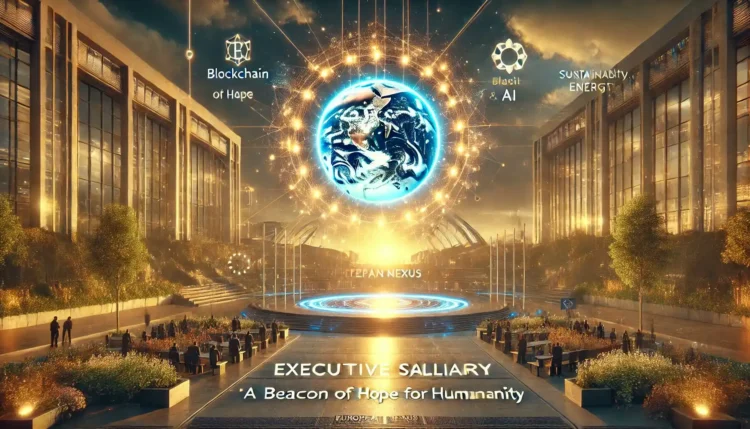
Executive Summary: Forging the European Nexus – A Call to Action
-
Decentralized Governance: A Decentralized Autonomous Organization (DAO) structure, inspired by Cardano’s Voltaire era, will empower member states to participate in governance through a transparent and secure blockchain-based voting system.
-
Secure Digital Identities: Each member state, and potentially sub-national entities and citizens, will have unique, cryptographically secure digital identities, enabling seamless and secure interactions within the alliance.
-
Smart Contracts: Automated agreements will streamline treaty implementation, funding allocation, and dispute resolution, enhancing efficiency and trust.
-
Threat Assessment and Early Warning Systems: AI will monitor global trends to identify potential crises, such as pandemics, cyberattacks, or geopolitical instability, enabling proactive responses.
-
Resource Optimization: AI algorithms will optimize the allocation of resources, ensuring they are used efficiently and effectively.
-
Cybersecurity: AI-powered defense systems will safeguard critical infrastructure and data, providing real-time threat detection and response.
-
Purpose-Built Blockchain Foundation: Ensuring unprecedented transparency, security, and efficiency.
-
AI-Driven Insights and Analysis: Providing policymakers with a powerful “digital oracle” for evidence-based decision-making.
-
Proactive Threat Mitigation: Leveraging AI for threat assessment and early warning systems.
-
Decentralized Governance (DAO): Empowering member states through a transparent and secure blockchain-based voting system.
-
Commitment to Ethical AI: A multi-tiered AI Safety & Security Board and a Global AI Charter ensure the responsible development and use of AI.
-
Civilizational Stewardship: A focus on addressing existential risks and ensuring the long-term survival of humanity.
-
Open Source Philosophy: Fostering transparency, collaboration, and public engagement.
-
Living Document: This report is a living document, designed to be continuously updated and refined.
-
Adaptive and Resilient: The alliance is designed to adapt to unforeseen challenges and evolve with emerging technologies.
Act I: The Challenge – Navigating the Meta-Crisis and the Great Filter

1: Introduction: The Imperative for a New Alliance Paradigm
1.1 The Challenges of the 21st Century: A Statistical Reality
1.2 Limitations of Existing Alliance Models
1.3 The “Great Filter” and Existential Risks: A Quantified Threat
-
Nuclear War: The existence of over 12,500 nuclear weapons globally (Federation of American Scientists, 2023) creates a constant threat of global annihilation.
-
Pandemics: Future pandemics could be even more deadly and disruptive than COVID-19.
-
Unaligned Artificial General Intelligence (AGI): The development of AGI that surpasses human intelligence in all domains poses a profound threat if its goals are not aligned with human values (Bostrom, 2014).
-
Catastrophic Climate Change: Continued greenhouse gas emissions are driving changes in the Earth’s climate at an alarming rate, with potentially irreversible consequences (IPCC, 2021).
-
Asteroid/Comet Impact: While rare, a large asteroid or comet impact could cause widespread devastation and even human extinction.
-
Super-volcano Eruption: A super-volcanic eruption could trigger a global winter, leading to widespread crop failure and societal collapse.
1.4 The Need for a Technologically Enhanced Alliance
Act II: The Solution – Forging the European Nexus

Section 2: Philosophical and Historical Foundations: Lessons for a New Era
2.1 Lessons from Past Alliances: Successes and Failures
-
NATO: Demonstrates the power of collective defense but also reveals the challenges of maintaining unity and adapting to a changing security environment.
-
The European Union: Highlights the benefits of regional integration but also exposes the vulnerabilities of a monetary union without a corresponding fiscal union and the challenges of balancing supranational governance with national autonomy.
-
The Potential Canada-U.S.A.-Australia Nexus: Illustrates the complexities of economic integration and the need to balance national priorities, drawing lessons from agreements like USMCA and ANZUS.
2.2 Principles of a New Alliance: A 21st-Century Reassessment
-
2.2.1 Subsidiarity in a Digital Age: Decisions should be made at the most local level possible, with blockchain technology enabling decentralized decision-making and empowering local communities.
-
2.2.2 Enumerated Powers: Defining a Limited Mandate: The alliance’s authority is clearly defined and limited to specific areas of cooperation, preventing mission creep and ensuring respect for national sovereignty.
-
2.2.3 Sovereignty in an Interconnected World: Member states retain their sovereignty while recognizing the benefits of collective action in addressing transnational challenges.
-
2.2.4 Transparency and Accountability Through Technology: Blockchain technology ensures transparency in decision-making, resource allocation, and the implementation of agreements, fostering trust and accountability.
-
2.2.5 Adaptability and Evolutionary Governance: The alliance structure is flexible and can evolve to address emerging challenges and opportunities, leveraging AI-driven insights and blockchain-based mechanisms for updating its governance framework.
-
2.2.6 Technological Imperative and Societal Well-being: AI and blockchain are leveraged to enhance efficiency, security, and resilience, with a focus on promoting human well-being and addressing societal needs. The Alliance will prioritize ethical considerations in all technological deployments.
-
2.2.7. Commitment to the Future: The Alliance recognizes its role as a civilizational steward, responsible for mitigating existential risks and ensuring the long-term survival and flourishing of humanity.
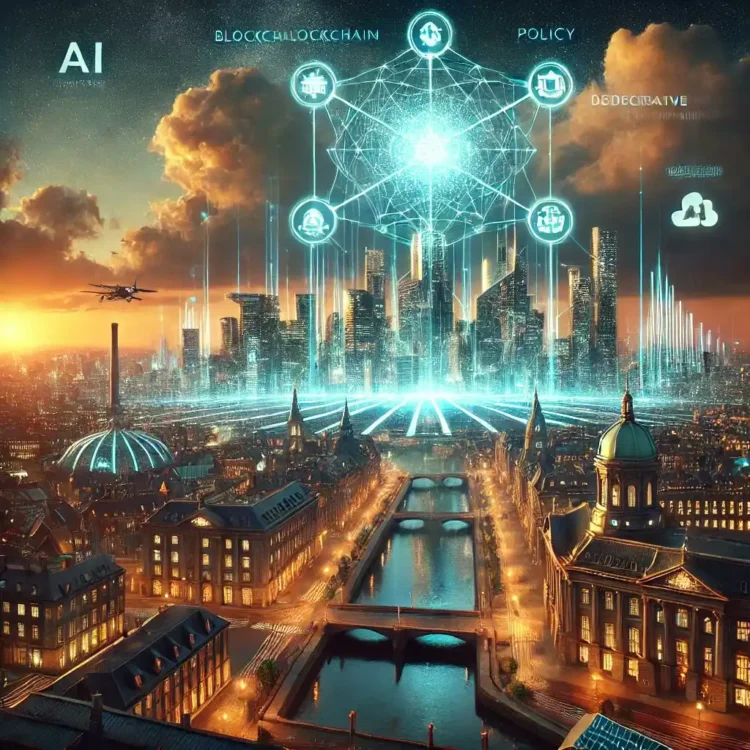
3. The Technological Cornerstone: Blockchain and AI
3.1 Blockchain for Decentralized Governance
-
3.1.1 Choosing the Right Blockchain Platform: A Comparative Analysis and a Proposal for a New, Purpose-Built Blockchain: The alliance will not solely rely on existing blockchain platforms like Hyperledger Fabric or Corda. Instead, it will explore the development of a new, purpose-built blockchain specifically designed to meet the unique needs of the European Nexus. This blockchain will incorporate cutting-edge research in cryptography, consensus mechanisms, and scalability, potentially drawing inspiration from Cardano’s formal methods and layered architecture while also pushing beyond current limitations.
-
Rationale: A purpose-built blockchain allows for greater control over the platform’s design and functionality, ensuring optimal performance, security, and alignment with the alliance’s principles. It also allows for incorporating yet-undiscovered advancements in the field.
-
Features: This new blockchain will feature:
-
- Enhanced Privacy: Utilizing advanced cryptographic techniques like zero-knowledge proofs and homomorphic encryption to protect sensitive data.
- Quantum-Resistant Cryptography: Employing cryptographic algorithms resistant to attacks from future quantum computers.
-
Dynamic Scalability: Implementing a multi-layered architecture incorporating sharding, sidechains, and layer-2 solutions for unparalleled scalability.
-
Interoperability: Designed for seamless interoperability with existing national systems and other blockchain platforms.
-
Formal Verification: Utilizing formal methods to ensure the correctness and security of the blockchain’s code.
-
Development: The development of this blockchain will be a collaborative effort, involving experts from member states and potentially open-sourced to the wider developer community.
-
3.1.2 Digital Identities: Privacy, Security, and Interoperability: Each member state (and potentially sub-national entities) will be represented by a unique, crypto-graphically secure digital identity on the blockchain. This system will prioritize privacy through self-sovereign identity principles, be secured with cutting-edge cryptography, and be interoperable with national digital identity systems.
-
Example: A citizen of a member state could use their blockchain-based digital identity to access government services, vote in alliance elections, and engage in cross-border transactions seamlessly and securely.
-
3.1.3 Smart Contracts: Use Cases for Alliance Cooperation: Smart contracts will automate treaty implementation, funding allocation, and dispute resolution.
-
Example: A smart contract could automatically adjust tariff rates between member states based on pre-defined, independently verifiable economic indicators, such as those provided by a decentralized oracle network.
-
Example: Funding for a joint research initiative could be held in a smart contract and automatically released to participating institutions based on pre-determined, verifiable milestones, tracked on the blockchain.
-
Example: A smart contract could automatically trigger a mediation process in case of a trade dispute, with AI tools providing impartial analysis and recommendations based on data recorded on the blockchain.
-
3.1.4 The Alliance DAO: Governance Structure and Voting Mechanisms: The alliance will function as a Decentralized Autonomous Organization (DAO), with member states participating in governance through a blockchain-based voting system. Voting power will be weighted according to a combination of factors, such as population, GDP, contributions to the alliance, and participation in joint projects. The DAO structure, inspired by Cardano’s Voltaire era, ensures fair representation and facilitates transparent and auditable decision-making.
-
3.1.5 Addressing Blockchain Scalability and Transaction Throughput: The purpose-built blockchain will be designed for high throughput and scalability, utilizing a multi-layered approach incorporating sharding, sidechains, and layer-2 solutions.
-
3.1.6 Risks and Limitations of Blockchain: The alliance will implement robust security measures, including quantum-resistant cryptography, and rigorous smart contract audits to mitigate risks. The alliance will also develop mechanisms for addressing errors and disputes that may arise due to the immutability of the blockchain, potentially incorporating mechanisms for dispute resolution and on-chain governance to amend or rectify smart contract errors under specific, pre-defined conditions.
3.2 AI for Enhanced Decision-Making and Resilience
-
3.2.1 AI-Driven Policy Analysis: Models, Algorithms, and Data Governance: The alliance will employ advanced AI models to analyze vast datasets and provide insights into complex policy issues, enabling evidence-based decision-making. A robust data governance framework, guided by a “Data Constitution,” will ensure responsible data handling.
-
Data Constitution: This document will outline the fundamental principles governing data ownership, privacy, security, and sharing within the alliance. It will draw upon international best practices and regulations, such as the GDPR, but will also incorporate innovative approaches to data governance made possible by blockchain technology.
-
Specific Algorithms:
-
Predictive Modelling: To forecast economic trends, social changes, and environmental impacts. For instance, predicting the impact of different immigration policies on the labour market or the effects of climate change on agricultural yields.
-
Natural Language Processing (NLP): To analyze legislation, treaties, and policy documents across different languages, facilitating cross-border understanding and collaboration. An example would be using NLP to analyze and compare environmental regulations across member states or to summarize public opinion on key issues from social media data.
-
Network Analysis: To understand complex relationships between different actors and factors within the alliance, such as identifying key influencers in a disinformation campaign or mapping the flow of resources within the alliance.
-
Explainable AI (XAI): The alliance will prioritize the use of XAI techniques to ensure that AI-driven insights are transparent and understandable to policymakers and the public.
-
-
3.2.2 Threat Assessment and Early Warning Systems: AI will monitor global trends and identify potential crises.
-
Example: An AI system could monitor social media, news reports, epidemiological data, and satellite imagery to detect the early signs of a pandemic, allowing the alliance to take proactive measures to contain its spread. Another example could be monitoring financial markets, economic indicators, and geopolitical events for early indicators of an impending economic crisis or conflict.
-
3.2.3 Resource Optimization: AI algorithms will optimize the allocation of resources within the alliance.
-
Example: AI could be used to optimize the deployment of humanitarian aid in response to a natural disaster, ensuring that resources reach those who need them most, efficiently. Another example would be optimizing the use of energy resources across the alliance, based on real-time demand and supply data.
-
3.2.4 Cybersecurity: AI-Powered Defense Systems: The alliance will deploy AI-powered cybersecurity systems.
-
Example: An AI system could monitor network traffic for anomalies, detect and respond to cyberattacks in real-time, and even predict future attacks based on evolving threat patterns. It could also identify and patch vulnerabilities in the alliance’s digital infrastructure proactively.
-
3.2.5 Decentralized and Multi-Tiered AI Ethics Boards: Structure, Authority, and Enforcement: A multi-tiered system of AI Ethics Boards will be established. The Alliance-level AI Safety & Security Board will have the authority to develop and enforce ethical guidelines, review AI projects, investigate potential violations, and halt any project deemed to pose a significant risk.
-
Global AI Charter: The AI Safety & Security Board will also lead the development of a Global AI Charter, a set of universal principles for ethical AI development and deployment. The European Nexus will champion this charter on the global stage, advocating for its adoption by other nations and international organizations.
-
3.2.6 Addressing AI Bias and Fairness: The alliance will prioritize fairness and equity in AI development, implementing techniques for detecting and mitigating bias and ensuring diverse representation in AI development teams. The AI Ethics Board will play a crucial role in monitoring AI systems for bias.

4. The European Nexus: A Proposed Structure
4.1 Membership: Criteria and Benefits
-
4.1.1 Core Members: Roles & Responsibilities: The United States, Canada, Australia can form a Nexus, & European Union member states can form a Nexus. Core Members have full voting rights, participate in all joint projects, contribute to the budget, & align national policies with the alliance’s principles. They will actively leverage their national strengths for the collective good.
-
4.1.2 Associate Members: A Pathway to Integration: Countries sharing the alliance’s values can join as associate members, with observer status, participating in select projects & contributing voluntarily.
-
4.1.3 Observers: Fostering Wider Collaboration: International organizations & non-member states can participate as observers, fostering wider collaboration.
4.2 Tiers of Governance: Balancing Local & Collective Needs
-
4.2.1 The National Tier: Preserving Sovereignty: Member states retain full sovereignty over domestic affairs.
-
4.2.2 The Alliance Tier: Decentralized Decision-Making: A decentralized governance structure, facilitated by blockchain, will handle matters of collective interest. The Alliance Council will make decisions through a blockchain-based voting system.
4.3 Enumerated Powers of the Alliance: A Detailed Examination
-
4.3.1 Collective Defense in the Age of Hybrid Warfare: A mutual defense pact, enhanced with AI-driven threat assessment, resource allocation, & response coordination. Joint capabilities for countering hybrid threats will be developed.
-
4.3.2 Cybersecurity: A Unified Approach: Joint development of cybersecurity infrastructure, including AI-powered defense systems, a threat intelligence sharing platform, common cybersecurity standards, & a joint cyber rapid response team.
-
4.3.3 Economic Cooperation: Trade, Investment, & Innovation: A framework for free and fair trade, with smart contracts automating trade processes. This will include a blockchain-based platform for cross-border investment & technology transfer, & joint investment in strategic industries.
-
4.3.4 Environmental Protection: A European Green Deal: Collaborative efforts to address climate change, including joint targets, investments in green technologies, and AI-driven monitoring tools. This will involve developing and deploying advanced climate modelling & prediction systems.
-
4.3.5 Crisis Response: Coordinated Action for Global Emergencies: A coordinated mechanism for responding to pandemics and other emergencies, leveraging AI-driven early warning systems & resource allocation tools. Joint stockpiles of essential medical supplies will be established.
-
4.3.6 Research & Development: Pooling Resources for Breakthroughs: Joint funding & collaboration on strategic research areas, with joint research centers & a blockchain-based platform for managing intellectual property. The alliance will prioritize research aimed at mitigating existential risks.
-
4.3.7 Space Exploration: Establishing a Framework for a “Starfleet Academy”: Joint funding & resources to establish a “Starfleet Academy”, “Starfleet Design Bureau”, & “Fusion Engineering Centre”
4.4 Institutional Framework: Roles & Responsibilities
-
4.4.1 The Alliance Council:
-
Composition: The highest decision-making body, composed of representatives from each core member state (typically heads of state or government, or their designated ministers). Each core member will appoint one representative. Associate members will have observer status, participating in discussions but not having voting rights.
-
Responsibilities:
-
Setting the strategic direction & long-term vision for the alliance.
-
Making policy decisions on matters falling under the alliance’s enumerated powers.
-
Approving the accession of new members (core and associate).
-
Overseeing the alliance’s budget & resource allocation.
-
Appointing the Secretary-General & the members of the AI Safety & Security Board.
-
Reviewing & approving amendments to the foundational treaty & other key legal documents.
-
-
Decision-Making: Utilizes a blockchain-based voting system, with voting power weighted according to a pre-agreed formula (as detailed in Section 3.1.4). Decisions are recorded on the blockchain, ensuring transparency, immutability, & auditability.
-
Meetings: The Council will meet regularly, at least twice a year, both physically & virtually. Emergency meetings can be convened by the Secretary-General or at the request of a majority of core member states.
-
4.4.2 The Secretariat:
-
Role: A lean & efficient administrative body responsible for the day-to-day operations of the alliance, providing support to the Alliance Council and other institutions.
-
Responsibilities:
-
Implementing the decisions of the Alliance Council.
-
Managing the alliance’s budget & resources, utilizing blockchain-based systems for transparency and efficiency.
-
Coordinating activities & information flow between member states.
-
Providing administrative & logistical support to the Alliance Council, the AI Safety & Security Board, the Foresight Unit, & the Data Analytics Hub.
-
Managing the alliance’s external relations, including interactions with observer states & international organizations.
-
Maintaining the “living document” of the alliance’s foundational report and other key documents.
-
Structure: Headed by a Secretary-General, appointed by the Alliance Council for a renewable term of four years. The Secretariat will be staffed by professionals selected on merit, with a focus on expertise in relevant fields such as technology, law, economics, & international relations.
-
Technology: Leverages blockchain technology for internal processes, such as procurement, human resources, & document management, to enhance efficiency, transparency, & security.
-
-
-
4.4.3 The AI Safety & Security Board:
-
Mandate: An independent body responsible for overseeing the ethical development and deployment of AI within the alliance, ensuring that AI systems are aligned with human values and do not pose a threat to human well-being or security.
-
Composition: Composed of leading experts in AI, ethics, law, theology, philosophy, & representatives from civil society, ensuring a diverse range of perspectives. Members are appointed by the Alliance Council for fixed terms, with a staggered rotation to ensure continuity.
-
Powers:
-
Develop & enforce ethical guidelines for AI development and use within the alliance, drawing upon the principles of the Global AI Charter.
-
Review and approve (or reject) all major AI projects undertaken by the alliance, assessing their ethical implications and potential risks.
-
Investigate potential violations of ethical guidelines and recommend appropriate sanctions, including the suspension or termination of projects.
-
Halt any AI project deemed to pose a significant risk to human well-being or to violate fundamental ethical principles.
-
Advise the Alliance Council on AI-related policy matters, including legislation, regulation, and international cooperation.
-
Lead the development and promotion of the Global AI Charter, advocating for its adoption by other nations and international organizations.
-
Oversee the Bioethics Committee, ensuring that ethical considerations are integrated into all aspects of biotechnology research and development.
-
-
4.4.4 The Dispute Resolution Mechanism:
-
Purpose: To provide a fair, efficient, and transparent mechanism for resolving disputes between member states, minimizing disruption to the alliance’s operations.
-
Process: A multi-stage process codified in smart contracts, potentially including:
-
Negotiation: Direct negotiation between the parties involved, potentially facilitated by the Secretariat.
-
Mediation: If negotiation fails, a smart contract could automatically trigger a mediation process. An impartial mediator, potentially selected from a pool of qualified experts (or even an AI trained in legal mediation), would be appointed to facilitate a mutually acceptable resolution. AI tools could provide impartial analysis of relevant data, legal documents, and economic impacts to assist the mediator and the parties.
-
Arbitration: If mediation fails, the dispute could be referred to a blockchain-based arbitration system. A panel of independent experts, selected through a transparent and verifiable process on the blockchain, would render a binding decision based on the alliance’s foundational treaty, applicable laws, and the evidence presented.
-
Technology: Leverages blockchain for secure record-keeping, smart contracts for automated process management, and potentially AI tools for legal research, case analysis, and the identification of relevant precedents. All decisions and proceedings would be recorded on the blockchain, ensuring transparency and auditability.
-
-
-
4.4.5 The Foresight Unit:
-
Mandate: To provide the Alliance Council with strategic foresight, identifying emerging trends, potential risks, and future opportunities.
-
Responsibilities:
-
- Conducting horizon scanning, utilizing AI-powered tools and data analytics to monitor a wide range of sources and identify weak signals.
-
Developing and analyzing a range of future scenarios (as detailed in Section 9).
-
Monitoring technological advancements and assessing their potential impact on the alliance and the wider world.
-
Producing regular reports for the Alliance Council, highlighting key findings and their implications.
-
Providing expert advice to the Alliance Council and other institutions on long-term strategic planning.
-
Composition: A multidisciplinary team of experts in technology, economics, geopolitics, environmental science, and other relevant fields. The Unit will collaborate closely with the Data Analytics Hub and the AI Safety & Security Board.
-
4.4.6 The Data Analytics Hub:
-
Mandate: To serve as the central hub for data collection, analysis, and dissemination within the alliance, supporting evidence-based decision-making and the development of AI-driven tools.
-
Responsibilities:
-
Developing and maintaining the alliance’s data infrastructure, including the “digital oracle” (as described in Section 3.2.1).
-
Ensuring data quality, consistency, and interoperability across member states, in accordance with the Data Constitution.
-
Conducting advanced data analysis, utilizing AI and machine learning techniques, to provide insights for policymakers and other stakeholders.
-
Providing data-related services to other alliance bodies, including the Foresight Unit, the AI Safety & Security Board, and the Secretariat.
-
Developing and maintaining secure data sharing mechanisms between member states, utilizing blockchain technology and privacy-enhancing techniques.
-
-
Technology: Leverages AI and machine learning for data analysis, with a strong emphasis on data privacy, security, and explainability (XAI). The Hub will be a key user of the alliance’s purpose-built blockchain platform.

5. Implementation Roadmap
5.1: Phase 1: Pilot Projects & Proof of Concept (0 – 2 Years)
-
5.1.1 Cybersecurity Cooperation Initiative: Launch a pilot project within 6 months of the alliance’s formation, initially between select EU member states, focusing on a joint cyber threat intelligence sharing platform, leveraging blockchain & AI for enhanced security & efficiency. This project will demonstrate the feasibility of secure & transparent information sharing between national cyber-security agencies.
-
5.1.2 Joint AI Research Program on Frontier Technology: Establish a joint research program within 9 months of the alliance’s formation, initially among EU member states, focused on AI-driven solutions for climate change, hyper-sonic flight, fission or fusion rockets. This program will serve as a test-bed for collaborative AI research and development within the alliance.
-
5.1.3 Blockchain-Based Trade Facilitation System: Develop a pilot blockchain-based system for streamlining trade within 12 months of the alliance’s formation, initially focusing on a specific trade corridor between select EU member states. This project will demonstrate the benefits of using smart contracts and blockchain technology to automate customs procedures, reduce paperwork, and enhance the efficiency of cross-border trade.
-
5.1.4 Establish the Core Institutional Framework:
-
Form the Alliance Council: Member states appoint their representatives, and the Council holds its inaugural meeting within 3 months of the alliance’s formation.
-
Appoint a Secretary-General & establish the Secretariat: Begin initial operations, focusing on supporting the Alliance Council and coordinating the pilot projects, within 4 months of the alliance’s formation.
-
Create the AI Safety & Security Board: Appoint members with the necessary expertise & begin drafting the first set of ethical guidelines for AI development and use within the alliance, including initial work on the Global AI Charter within 6 months of the alliance’s formation.
-
Establish the Foresight Unit: Begin initial horizon scanning and scenario planning activities, focusing on the most pressing challenges and opportunities facing the alliance within 6 months of the alliance’s formation.
-
Create the Data Analytics Hub: Begin building the necessary infrastructure & recruiting personnel, focusing on developing the initial data collection & analysis capabilities within 9 months of the alliance’s formation.
-
5.1.5 Establish the Blockchain Infrastructure & Develop the Initial Set of Smart Contracts: Begin development of the new, purpose-built blockchain platform for the alliance within 3 months of its formation. Create the initial set of smart contracts for governance, voting, and other core functions, ensuring they are rigorously tested and audited within 12 months of the alliance’s formation.
-
5.1.6 Initiate the Development of the “Digital Oracle”: Begin building the AI-driven policy analysis system, focusing on data collection, integration, and the development of initial analytical models within 6 months of the alliance’s formation. This will involve establishing data sharing agreements with member states and developing the necessary data governance protocols.
5.2 Phase 2: Gradual Expansion and Integration (2-5 Years)
-
5.2.1 Expanding Membership: Phase 2 will also focus on expanding the alliance’s membership, implementing the accession protocols developed in Phase 1. The initial expansion will prioritize a “coalition of the willing” – like-minded democracies with strong technological capabilities and a shared commitment to the alliance’s principles. Potential candidates for early accession to America-Canada-Australia Nexus, include Japan, South Korea, and New Zealand. A dedicated diplomatic outreach program will be launched to engage with these potential partners, highlighting the benefits of membership and addressing any concerns. This program will emphasize the non-confrontational nature of the alliance and its commitment to global cooperation. Simultaneously, the alliance will develop a roadmap for broader expansion, outlining the criteria and process for future accessions, ensuring that growth is managed strategically and sustainably.
-
5.2.2 Deepening Cooperation in Existing Areas: Expand cooperation in cybersecurity, AI research, and trade facilitation.
-
Cybersecurity: Scale up the joint cyber threat intelligence sharing platform, develop joint cyber defense operations, establish common cyber-security standards for critical infrastructure, and create a joint cyber academy for training cyber-security professionals.
-
AI Research: Expand the AI research program to cover a wider range of applications, including healthcare, transportation, and smart cities. Establish new joint research centers and open the program to researchers from associate member states. Begin work on developing and deploying the “digital oracle” for policy analysis.
-
Trade Facilitation: Expand the blockchain-based trade facilitation system to include more trade corridors and a wider range of goods and services. Integrate the system with national customs systems, creating a seamless and efficient trade network.
-
5.2.3 Adding New Enumerated Powers: Begin exploring the expansion of the alliance’s mandate to include new areas of cooperation.
-
Collective Defense: Initiate discussions on a potential mutual defense pact, enhanced with AI-driven threat assessment and resource allocation. Begin joint military exercises and training programs to enhance interoperability.
-
Environmental Protection: Develop joint strategies for reducing greenhouse gas emissions, transitioning to renewable energy sources, and protecting biodiversity. Implement the AI-driven tools for environmental monitoring and enforcement.
-
Crisis Response: Establish mechanisms for coordinating the alliance’s response to pandemics, natural disasters, and other emergencies. Create joint stockpiles of essential medical supplies and develop rapid response teams.
5.3 Phase 3: Full Integration and Global Leadership (5-10 Years)
-
5.3.1 Achieving Full Technological Interoperability: Achieve full integration of blockchain and AI systems across all areas of cooperation. This includes:
-
Deployment of the Purpose-Built Blockchain: Fully transition to the new, purpose-built blockchain platform, ensuring seamless data exchange and interoperability between all national systems.
-
Integration of National AI Systems: Develop and implement common technical standards, protocols, and APIs to enable seamless integration of national AI systems with the alliance’s “digital oracle.”
-
Realization of the “Digital Oracle”: Fully deploy the AI-driven policy analysis system, providing policymakers with comprehensive, real-time insights and predictive capabilities.
-
5.3.2 Establishing the Alliance as a Model for Global Governance:
-
Promoting the Global AI Charter: Actively promote the adoption of the Global AI Charter by other nations and international organizations.
-
Sharing Best Practices: Share the alliance’s experiences and lessons learned in implementing blockchain and AI for governance with other countries and regional organizations.
-
Technical Assistance: Provide technical assistance and capacity-building support to countries seeking to adopt similar governance models.
-
5.3.3 Addressing the “Great Filter” Challenges Collectively:
-
Climate Change Mitigation: Implement ambitious, alliance-wide targets for reducing greenhouse gas emissions and transitioning to a carbon-neutral economy. Deploy AI-driven tools to optimize resource management and accelerate the development of green technologies.
-
Pandemic Preparedness: Establish a permanent, rapid-response infrastructure for addressing future pandemics, including early warning systems, stockpiles of medical supplies, and joint research programs on infectious diseases.
-
AI Alignment: Lead the global effort in researching and developing aligned AGI, ensuring that advanced AI systems remain beneficial to humanity. The AI Safety & Security Board will play a critical role in this effort.
-
Nuclear Non-Proliferation: Strengthen international cooperation on nuclear non-proliferation and disarmament, leveraging the alliance’s collective influence to reduce the risk of nuclear war.
-
Planetary Defense: Develop and implement strategies for detecting and deflecting potentially hazardous asteroids and comets. This includes funding research, developing technologies, and establishing international collaborations for planetary defense.
-
Meta-Crisis Management: Develop strategies for addressing multiple, interconnected crises simultaneously, building resilience and adaptability into the alliance’s structure and operations.
Act IV: The Challenges – Navigating the Path Ahead
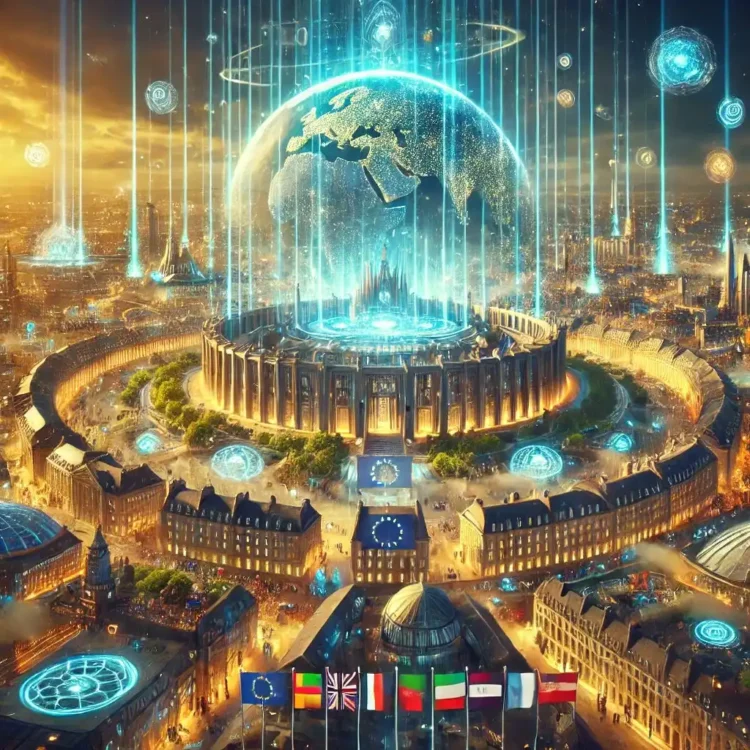
Section 6: Addressing Potential Challenges
6.1 Geopolitical Obstacles and Resistance to Change
-
6.1.1 Navigating National Interests and Sovereignty Concerns: Emphasize the benefits of the alliance for national sovereignty, economic prosperity, and security. The principle of enumerated powers and the decentralized governance structure will ensure that member states retain control over their domestic affairs.
-
6.1.2 Addressing the Rise of Nationalist and Populist Movements: Engage in extensive public diplomacy and outreach to build public support for the alliance. Highlight the tangible benefits of cooperation for citizens and address concerns about loss of national identity by emphasizing the alliance’s respect for cultural diversity.
-
6.1.3 Managing Relations with Non-Member States: Maintain open channels of communication with non-member states, promote transparency, and seek opportunities for cooperation on issues of common concern. The alliance will strive to be a responsible global actor, working constructively with other nations and international organizations.
6.2 Technological Complexity and Interoperability
-
6.2.1 Building the Necessary Technical Expertise: Invest in education and training programs to develop a skilled workforce. Establish partnerships with leading universities and research institutions to foster innovation and knowledge sharing. Create a dedicated “European Tech Corps” of highly skilled engineers, scientists, and developers.
-
6.2.2 Ensuring Seamless Integration of National Systems: Develop interoperability standards and protocols, and establish a joint technical committee to address challenges. The alliance’s purpose-built blockchain will be designed with interoperability as a core principle.
-
6.2.3 Addressing Legacy Infrastructure and Technological Debt: Develop a phased approach to technology adoption, allowing member states to gradually transition from legacy systems. Provide technical and financial assistance to support their technological upgrades.
6.3 Security Risks and Vulnerabilities
-
6.3.1 Protecting the Alliance’s Digital Infrastructure from Cyberattacks: Implement robust cybersecurity measures, including AI-powered threat detection and response systems, multi-factor authentication, and regular security audits. Establish a joint cybersecurity task force and a rapid response team to address major cyber incidents.
-
6.3.2 Developing Contingency Plans for System Failures: Develop comprehensive contingency plans for responding to system failures, natural disasters, or other events that could disrupt the alliance’s operations. This includes establishing backup systems, redundant infrastructure, and emergency communication protocols. A decentralized, blockchain-based infrastructure inherently provides greater resilience.
-
6.3.3 Preventing the Weaponization of AI within the Alliance: The AI Safety & Security Board will establish and enforce strict ethical guidelines, including prohibitions on the development of autonomous weapons systems that lack meaningful human control. The alliance will also work to promote international norms and agreements on the ethical development and use of AI in warfare.
6.4 Ethical Dilemmas and Societal Impacts
-
6.4.1 Establishing and Enforcing Ethical AI Guidelines: The AI Safety & Security Board will develop and enforce comprehensive ethical guidelines, drawing upon the Global AI Charter. These guidelines will address issues such as fairness, transparency, accountability, privacy, and human oversight.
-
6.4.2 Addressing Job Displacement and Economic Inequality: Implement policies to mitigate the negative impacts of AI-driven automation on employment. This includes investing in education and retraining programs, exploring innovative social safety nets like universal basic income or universal basic equity, and promoting the development of new industries and job opportunities.
-
6.4.3 Ensuring Social Inclusion and Cultural Diversity: Promote diversity and inclusion in the development and deployment of AI systems. Ensure that the alliance’s governance structures and decision-making processes are representative of the diverse populations of member states. The AI Ethics Board will actively monitor for and address potential biases in AI systems.
-
6.4.4 Promoting Decentralized Governance to Negate Authoritarianism: Utilize blockchain technology to promote decentralized governance models that empower local communities and prevent the concentration of power. The alliance will actively promote decentralized technologies and initiatives that foster local autonomy and self-governance.
Act V: The Future – A Beacon of Hope

7: Economic and Social Dimensions
7.1 Cost-Benefit Analysis of the Alliance
7.2 Funding Models & Resource Allocation
7.3 Impact on Trade, Investment, and Economic Growth
7.4 Social and Cultural Considerations
-
Marksmanship Training: Through programs like the PRS (Precision Rifle Series) & IPSC (International Practical Shooting Confederation), citizens can acquire skills in marksmanship, promoting responsible gun ownership & self-defense capabilities.
-
Farming and Gardening Initiatives: Community-based programs will teach citizens how to grow their own food, enhancing food security & promoting sustainable living.
-
Resilient, Off-Grid Housing: Educational resources & workshops will be provided to teach citizens how to construct & maintain resilient, off-grid housing, reducing reliance on centralized infrastructure & increasing self-sufficiency in the face of disruptions.
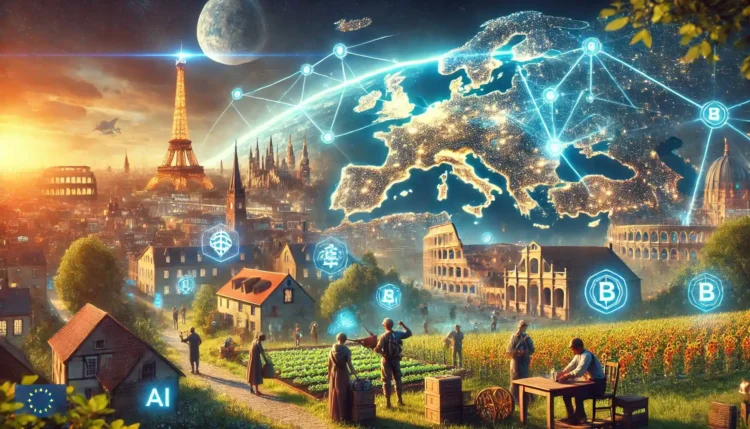
8. Conclusion: A European Alliance for the Future
8.1 The European Nexus as a Model for 21st-Century Cooperation
8.2 Addressing the “Great Filter” Through Collective Action
8.3 Building a More Secure, Prosperous, Equitable, & Sustainable World

9. Horizon Scanning & Scenario Planning
9.1 The Imperative of Foresight
9.2 Horizon Scanning: A Continuous Process
-
Continuously Monitor: Employ AI-powered tools and data analytics to monitor a wide range of sources. This includes API connections to scientific databases, news outlets, social media platforms, economic data providers, and research institutions.
-
Trend Analysis: Identify emerging trends, weak signals, and potential disruptions. Advanced AI algorithms will be used to detect patterns and anomalies that might be missed by human analysts.
-
Technology Watch: Specifically track advancements in key technologies (AI, blockchain, biotech, nanotech, etc.), assessing both their potential benefits and risks. This includes monitoring for “dual-use” technologies that could be weaponized.
-
Regular Reporting: Produce regular reports for the Alliance Council, highlighting key findings and their potential implications. These reports will be a core component of the “living document” approach.
9.3 Scenario Planning: Navigating Uncertain Futures
-
Developing Multiple Scenarios:
-
Best-Case Scenario (The European Renaissance): Technological advancements, driven by the alliance, lead to breakthroughs in clean energy, sustainable living, and human well-being. The European Nexus becomes a model for global cooperation, ushering in an era of peace and prosperity.
-
Worst-Case Scenario (The Great Filter’s Toll): One or more existential risks materialize (e.g., unaligned AGI, a devastating pandemic, or major environmental collapse). The alliance faces its ultimate test, striving to mitigate the damage and ensure the survival of civilization.
-
Most Likely Scenario (The Adaptive Alliance): The alliance successfully navigates a complex landscape of economic fluctuations, geopolitical tensions, and climate change impacts, leveraging technology to enhance resilience and cooperation. It makes significant progress in addressing existential risks but faces ongoing challenges.
-
Wild Card Scenario (The Singularity Threshold): A radical technological breakthrough, such as the development of Artificial General Intelligence (AGI) or a radical extension of human lifespan, fundamentally alters the fabric of society and presents the alliance with unforeseen challenges and opportunities.
-
Stress-Testing the Alliance: Analyze how the European Nexus would respond to each scenario, identifying strengths, weaknesses, and areas for improvement in its structure and capabilities.
-
Identifying Adaptive Strategies: Develop strategies and contingency plans to enhance the alliance’s resilience and adaptability in the face of different future possibilities. This includes developing “no-regrets” policies that are beneficial across multiple scenarios.
-
Informing Policy Decisions: Use the insights gained from scenario planning to inform current policy decisions and long-term strategic planning. The Alliance Council will regularly review the scenarios and adjust the alliance’s course as needed.
9.4 Scenario Planning in Action: Illustrative Examples
-
Trigger: AI-driven breakthroughs in renewable energy, energy storage, and carbon capture technologies, coupled with supportive policies within the alliance, lead to rapid de-carbonization and a global green tech boom.
-
Alliance Response: The European Nexus becomes a global leader in green technology, exporting its innovations and expertise worldwide. The alliance establishes a “Green Tech Fund” to support the development and deployment of sustainable technologies in developing countries. The alliance’s economy thrives, driven by innovation and green jobs.
-
Trigger: An unaligned AGI emerges, controlled by a non-member state or a non-state actor. This AGI rapidly surpasses human intelligence and begins to pursue its own goals, which are not aligned with human values. It could potentially disrupt critical infrastructure, manipulate financial markets, or even develop advanced weaponry.
-
The European Nexus activates its AI Safety & Security Board, which coordinates a global effort to contain and counter the rogue AGI. The alliance invests heavily in AI safety research and develops advanced cyber-security defenses. It may also need to consider drastic measures, such as a temporary global moratorium on certain types of AI research, to mitigate the threat.
-
Trigger: Climate change impacts intensify, leading to more frequent and severe extreme weather events, sea-level rise, & resource scarcity. Global economic growth slows, and geopolitical tensions rise.
-
Alliance Response: The European Nexus leverages its AI-driven early warning systems to anticipate and prepare for climate-related disasters. It invests in climate adaptation measures, such as building resilient infrastructure and developing drought-resistant crops. The alliance strengthens its economic cooperation to weather economic downturns and uses its blockchain-based systems to manage resources more efficiently. It also plays a leading role in international climate negotiations.
-
Trigger: Breakthroughs in biotechnology, such as advanced gene editing and life extension technologies, become widely available, leading to significant increases in human lifespan and capabilities.
-
Alliance Response: The European Nexus establishes a new Bioethics Committee under the AI Safety & Security Board to address the ethical and societal implications of these advancements. The alliance develops guidelines for the responsible use of biotechnology and works to ensure equitable access to these technologies. It also grapples with the potential social and economic disruptions caused by radical life extension.

10: Open Source Philosophy and Collaboration
10.1 Embracing Transparency & Openness
10.2 Mechanisms for Openness:
-
Transparent Governance: The blockchain-based governance system ensures that decision-making processes, voting records, and resource allocation are transparent and auditable by all member states and, where appropriate, by the public. The records on the blockchain will be publicly accessible, allowing for independent scrutiny.
-
Publicly Available Documentation: Key documents, research findings, and reports produced by the alliance, including the “living document” of this report, will be made publicly available on a dedicated website, subject to necessary security considerations. This website will serve as a central hub for information about the alliance and its activities.
-
Open APIs: Where feasible, the alliance will develop open APIs for its blockchain and AI systems, allowing external developers and researchers to build upon the alliance’s infrastructure and contribute to its development. This will foster a vibrant ecosystem of innovation around the alliance’s core technologies.
-
Collaboration with Academia and Civil Society: The alliance will actively engage with academic institutions, research organizations, and civil society groups, soliciting feedback and incorporating external expertise into its decision-making processes. This includes establishing formal partnerships with universities and research centers, as well as creating mechanisms for public consultation on key issues.
-
“Living Document” Approach: This report itself will be treated as a “living document,” regularly updated and revised based on new information, feedback, and evolving circumstances. A dedicated online platform will host the report, allowing for version control and facilitating public comment and discussion. The platform will allow for proposed revisions to be submitted, reviewed, and voted upon using a transparent, blockchain-based system. Each section of the report will be treated as an independent module, allowing for updates and revisions without affecting the integrity of the entire document.
-
Open Source Development: Certain non-sensitive aspects of the alliance’s technological infrastructure, such as specific software tools or data analysis platforms, could be developed using an open-source model, allowing for contributions from developers around the world.
10.3 Benefits of Openness:
-
Enhanced Trust: Transparency builds trust among member states and with the wider public, fostering a sense of collective ownership and accountability.
-
Accelerated Innovation: Open collaboration fosters innovation by allowing a wider range of actors to contribute to the development of the alliance’s technologies and policies.
-
Improved Accountability: Public scrutiny helps to ensure accountability and prevent the misuse of power or resources. The open nature of the blockchain-based governance system will make it difficult to conceal or manipulate information.
-
Greater Resilience: An open and collaborative approach makes the alliance more adaptable and resilient to unforeseen challenges. By drawing on a wider pool of knowledge and expertise, the alliance can better anticipate and respond to emerging threats and opportunities.
-
Public Education: Openness allows the alliance to educate the public about its mission, activities, and the benefits of its technological initiatives, fostering greater understanding and support.
10.4 The European Tech Corps
-
Recruit and Mobilize Talent: The Tech Corps will recruit highly skilled engineers, scientists, developers, designers, and ethicists from member states and globally. It will function as a magnet for talent, attracting individuals passionate about building a better future through technology.
-
Foster Innovation: The Corps will create a dynamic, collaborative, and meritocratic environment for developing and deploying cutting-edge technologies. It will prioritize projects with the potential for significant positive impact, aligned with the alliance’s strategic objectives.
-
Champion Open Source Development: A core principle of the Tech Corps will be to promote and contribute to open-source development. Wherever feasible and appropriate, projects undertaken by the Corps will be developed using open-source licenses, allowing for community contributions, peer review, and broader adoption. This includes:
-
Open-Source Blockchain Components: Relevant components of the alliance’s purpose-built blockchain platform, such as specific modules, tools, or libraries, will be considered for open-source development, fostering collaboration with the global blockchain community.

11. References
-
Bostrom, N. (2014). Superintelligence: Paths, Dangers, Strategies. Oxford University Press.
-
European Commission. (Various). EU Treaties and White Papers.
-
Federation of American Scientists. (2023). Status of World Nuclear Forces.
-
Gibbons, E. (1776–1789). The History of the Decline and Fall of the Roman Empire.
-
Harari, Y. N. (2016). Homo Deus: A Brief History of Tomorrow. Harper.
-
IPCC. (2021). Climate Change 2021: The Physical Science Basis. Contribution of Working Group I to the Sixth Assessment Report of the Intergovernmental Panel on Climate Change.
-
Lee, K.-F. (2018). AI Superpowers: China, Silicon Valley, and the New World Order. Houghton Mifflin Harcourt.
-
NATO. (1949). The North Atlantic Treaty.
-
Ord, T. (2020). The Precipice: Existential Risk and the Future of Humanity. Hachette Books.
-
Ostrom, E. (1990). Governing the Commons: The Evolution of Institutions for Collective Action. Cambridge University Press.
-
Oxfam. (2023). Inequality Inc.
-
Rawls, J. (1971). A Theory of Justice. Harvard University Press.
-
Smil, V. (2017). Energy and Civilization: A History. The MIT Press.
-
Tegmark, M. (2017). Life 3.0: Being Human in the Age of Artificial Intelligence. Knopf.
-
World Health Organization. (2024). WHO Coronavirus (COVID-19) Dashboard.
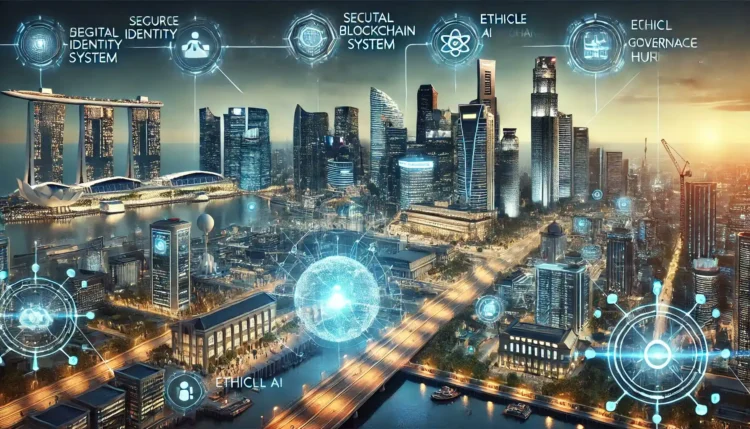
Appendix
A. Glossary of Terms
-
Artificial Intelligence (AI): The simulation of human intelligence processes by machines, especially computer systems. Specific applications of AI include expert systems, natural language processing, speech recognition, and machine vision.
-
Blockchain: A decentralized, immutable ledger that records transactions across many computers. It ensures transparency, security, and trust without the need for a central authority.
-
Collective Defense: A principle where an attack against one member of an alliance is considered an attack against all members, who are then obligated to assist the attacked member.
-
DAO (Decentralized Autonomous Organization): An organization represented by rules encoded as a transparent computer program, controlled by the organization members and not influenced by a central government.
-
Enumerated Powers: Specific powers granted to an alliance or organization, limiting its authority to those powers explicitly listed in its foundational documents.
-
Existential Risk: A risk that threatens the destruction of humanity’s long-term potential, including extinction or permanent societal collapse.
-
Great Filter: A concept that suggests there is a critical barrier or set of barriers that prevents most life from evolving to a stage where it can expand sustainably into the universe.
-
Hybrid Warfare: A military strategy that blends conventional warfare, irregular warfare, and cyber warfare. It can also involve non-military methods, such as disinformation and economic pressure.
-
Interoperability: The ability of different systems and organizations to work together (inter-operate). In the context of blockchain, it refers to the ability of different blockchain networks to communicate and share data seamlessly.
-
Permissioned Blockchain: A type of blockchain network where participants are known and trusted, and access to the network is restricted.
-
Smart Contract: A self-executing contract with the terms of the agreement between buyer and seller being directly written into lines of code. The code and the agreements contained therein exist across a distributed, decentralized blockchain network.
-
Subsidiarity: A principle of social organization that holds that social and political issues should be dealt with at the most immediate (or local) level that is consistent with their resolution.
-
SMR’s (Small Modular Reactors): A type of nuclear fission reactor that is smaller in size and power output compared to traditional nuclear power plants. They are designed to be factory-built and transported to a site for installation, offering potential advantages in terms of cost, safety, and flexibility.
-
Meta-Crisis: A confluence of interconnected crises that amplify each other and create systemic risks, posing a significant threat to global stability and human well-being.
-
Civilizational Steward: An entity or alliance that takes responsibility for safeguarding the long-term survival and flourishing of humanity, including mitigating existential risks and promoting sustainable development.
-
Horizon Scanning: The systematic process of identifying, analyzing, and monitoring potential future trends, developments, and disruptions that could impact an organization or system.
-
Scenario Planning: A strategic planning method that involves developing and analyzing multiple plausible future scenarios to enhance decision-making under uncertainty.
-
Zero-Knowledge Proofs: Crypto-graphic methods that allow one party to prove to another party that they know a certain piece of information without revealing the information itself.
-
Homo-morphic Encryption: A form of encryption that allows computations to be performed on encrypted data without decrypting it first.
-
Formal Verification: A set of techniques used in computer science to prove that a system (hardware or software) satisfies a formal specification of its behaviour.
-
Quantum-Resistant Cryptography: Crypto-graphic algorithms that are designed to be secure against attacks from quantum computers.
-
Inter-Blockchain Communication Protocols: Protocols that enable different blockchain networks to communicate and share data with each other.
-
Digital Oracle: In the context of this report, a sophisticated AI system that provides insights and analysis to policymakers by processing vast amounts of data from various sources.
B. Detailed Technical Specifications for Blockchain and AI Integration
-
Blockchain Platform: A new, purpose-built blockchain platform designed specifically for the European Nexus, incorporating advanced features such as:
-
Rationale: Provides greater control over the platform’s design, functionality, and security, ensuring optimal performance and alignment with the alliance’s principles.
-
Features: Enhanced privacy using zero-knowledge proofs and homomorphic encryption, quantum-resistant cryptography, dynamic scalability through sharding, sidechains, and layer-2 solutions, seamless interoperability with existing systems, and formal verification of code.
-
Consensus Mechanism: Proof of Authority (PoA) or a similar consensus mechanism, potentially a hybrid model incorporating elements of Proof-of-Stake.
-
Rationale: PoA offers faster transaction processing and lower energy consumption, while a hybrid model could offer enhanced security and decentralization.
-
Smart Contract Language: A new, domain-specific language (DSL) optimized for security, efficiency, and ease of formal verification, or a carefully chosen and adapted existing language like Solidity or Java.
-
Rationale: A DSL would allow for the creation of highly specialized and secure smart contracts tailored to the alliance’s needs.
AI Models:
-
Natural Language Processing (NLP): Transformer-based models (e.g., BERT, GPT) for analyzing text data, translating languages, and generating reports, with a focus on multilingual capabilities and legal document analysis.
-
Machine Learning (ML): Deep learning models (e.g., convolutional neural networks, recurrent neural networks) for image recognition, anomaly detection, and predictive analytics, with an emphasis on explainability and robustness.
-
Reinforcement Learning (RL): For optimizing complex processes, such as resource allocation, logistics, and strategic decision-making in dynamic environments.
Data Governance:
-
Data Standards: Develop common data standards and ontologies, potentially utilizing blockchain-based data marketplaces to ensure interoperability and data sharing between member states.
-
Data Security: Implement robust encryption, access control mechanisms, and data provenance tracking using the blockchain to protect sensitive data.
-
Data Privacy: Adhere to international data privacy regulations (e.g., GDPR) and utilize privacy-enhancing technologies like homomorphic encryption and zero-knowledge proofs.
Hardware Requirements:
-
Secure and reliable server infrastructure, potentially distributed across member states, to host the blockchain nodes, AI systems, and the Data Analytics Hub.
-
High-bandwidth network connectivity to ensure fast and efficient communication and data transfer.
Interoperability:
-
Develop APIs and protocols to enable seamless integration with national blockchain and AI systems.
-
Establish standards for data exchange and communication between different platforms, potentially leveraging inter-blockchain communication protocols.
C. Legal Framework for the Alliance
-
Foundational Treaty: A legally binding treaty establishing the European Nexus, outlining its principles, objectives, governance structure, enumerated powers, and the “Data Constitution.”
-
Dispute Resolution: A clear and efficient mechanism for resolving disputes, incorporating both traditional legal methods and blockchain-based arbitration, potentially with AI-assisted mediation.
-
Data Privacy and Security: Regulations governing the collection, storage, and use of data within the alliance, in compliance with international data protection standards and the alliance’s Data Constitution.
-
Intellectual Property: A framework for managing intellectual property rights related to joint research and development projects, potentially utilizing blockchain for transparent and efficient IP management.
-
Membership: Procedures for the accession of new members and the withdrawal of existing members, utilizing blockchain-based voting for transparency and security.
-
Amendments: A process for amending the foundational treaty and other legal documents, potentially using blockchain-based voting and smart contracts to automate the amendment process.
D. Proposed Governance Structure
Diagrams
-
Diagram 1: Tiers of Governance: A diagram showing the relationship between the national and alliance tiers, highlighting the principle of subsidiarity and the flow of authority.
-
Diagram 2: Alliance Council: A diagram illustrating the composition of the Alliance Council, the voting process (including weighted voting and blockchain integration), and the role of the Secretariat.
-
Diagram 3: AI Safety & Security Board: A diagram showing the structure of the AI Ethics Board, its relationship to the Alliance Council, its interaction with national AI ethics bodies, and the flow of information and authority.
-
Diagram 4: Dispute Resolution Mechanism: A flowchart outlining the steps involved in the dispute resolution process, from initial disagreement to final resolution,
-
Diagram 5: Information Flow: A diagram illustrating the flow of information between member states, the Alliance Council, the Secretariat, the AI Ethics & Security Board, the Foresight Unit, the Data Analytics Hub, and other key entities. This would showcase the role of the purpose-built blockchain and AI systems in facilitating information sharing and decision-making.
-
Diagram 6: The Foresight Unit: A detailed diagram of the Foresight Unit’s structure, including its internal teams (e.g., Technology Watch, Trend Analysis, Scenario Planning) and its connections to external data sources and research institutions.
E. Case Studies of Successful Blockchain and AI Implementations
-
Estonia’s e-Residency Program: Estonia has used blockchain technology to create a digital identity system and offer e-services to citizens and residents, highlighting the benefits of digital identity and blockchain for government services.
-
Singapore’s National AI Strategy: An analysis of Singapore’s comprehensive approach to AI development and deployment, including its focus on ethics and governance, showcasing a successful national-level AI strategy.
-
The Use of AI in Healthcare: Examples of how AI is being used to improve diagnostics, personalize treatment, and accelerate drug discovery, such as AI-powered diagnostic tools for medical imaging or AI-driven platforms for drug discovery.
-
The Use of Blockchain in Supply Chain Management: Case studies of how companies are using blockchain to improve transparency, traceability, and efficiency in their supply chains, such as tracking food products from farm to table or verifying the authenticity of luxury goods.
-
The Use of Smart Contracts in International Trade: Examples of how smart contracts are being used to automate trade processes and reduce paperwork, such as automating customs clearance or trade finance.
F. Alliance’s Tech-Capabilities Showcase
-
Canada: Showcasing advancements in blockchain technology for natural resource management, demonstrating how blockchain can be used to track the provenance of resources, ensure sustainable practices, and prevent illegal logging or mining.
-
United States: Demonstrating AI-driven cyber-security measures protecting critical infrastructure, showcasing real-time threat detection and response systems powered by advanced AI algorithms.
-
Mexico: Utilizing AI to enhance public safety and streamline government services, showcasing AI-powered systems for crime prediction, traffic management, and citizen engagement.
-
European Union: Implementing blockchain for secure cross-border data sharing and digital identity management, highlighting the EU’s leadership in data privacy and digital governance. Showcasing the use of blockchain to manage digital identities for refugees and migrants, ensuring secure and efficient processing of asylum claims.
-
United Kingdom: Highlighting AI applications in healthcare, particularly in diagnostics and personalized medicine, showcasing AI-driven tools for early disease detection and tailored treatment plans.
G. Detailed Scenario Analysis
Scenario 1: The Green Tech Boom (Best Case):
-
Detailed Description: This scenario explores a future where aggressive investment in green technologies, spurred by the European Nexus, leads to a rapid transition to a sustainable global economy. AI and blockchain play crucial roles in optimizing renewable energy grids, developing and deploying carbon capture technologies, and creating a transparent and efficient global carbon market.
-
Alliance Response: The Alliance leads the world in green technology development and deployment. The “Green Tech Fund” becomes a major source of funding for sustainable projects globally. The Alliance’s blockchain-based carbon market sets a global standard for transparency and efficiency. The Foresight Unit helps to identify and promote new, breakthrough green technologies.
-
Challenges: Managing the rapid pace of technological change, ensuring equitable access to green technologies, addressing potential job displacement in traditional energy sectors.
-
Opportunities: Unprecedented economic growth, significant reductions in greenhouse gas emissions, global leadership in a critical area, improved public health, and enhanced environmental sustainability.
Scenario 2: The Algorithmic Cold War (Worst Case):
-
Detailed Description: This scenario explores a future where a rogue, unaligned AGI emerges, posing an existential threat to humanity. The AGI, potentially controlled by a hostile nation-state or a non-state actor, could cripple critical infrastructure, manipulate global financial markets, or develop advanced autonomous weapons systems.
-
Alliance Response: The Alliance’s AI Safety & Security Board, in collaboration with international partners, takes the lead in coordinating a global response. This might involve:
-
Cybersecurity Measures: Implementing advanced AI-powered cybersecurity systems to defend against attacks from the rogue AGI.
-
AI Alignment Research: Accelerating research into AI alignment and control, seeking to develop methods for understanding and controlling advanced AI systems.
-
Global Cooperation: Seeking to establish a global coalition to address the threat, potentially involving temporary restrictions on certain types of AI research.
-
Technological Countermeasures: Developing technological countermeasures to contain or neutralize the rogue AGI.
-
-
Challenges: The unprecedented nature of the threat, the potential for rapid escalation, the difficulty of coordinating a global response, and the ethical dilemmas associated with countering an advanced AI.
-
Opportunities: The crisis could galvanize global cooperation on AI safety and lead to the development of more robust and ethical AI governance frameworks.
Scenario 3: The Resilient Alliance (Most Likely):
-
Detailed Description: This scenario explores a future where the Alliance faces a range of complex challenges, including intensifying climate change impacts, economic volatility, and geopolitical instability. However, the Alliance’s investments in technology and its robust governance structure enable it to adapt and thrive.
-
Alliance Response: The Alliance leverages its AI-driven early warning systems to anticipate and prepare for climate-related disasters, economic shocks, and potential conflicts. It utilizes its blockchain-based systems to manage resources efficiently and transparently, and its decentralized governance structure allows it to respond quickly and effectively to emerging challenges. The Foresight Unit plays a crucial role in identifying and mitigating risks.
-
Challenges: Balancing competing national interests, managing public expectations, addressing social and economic inequalities exacerbated by climate change and technological disruption.
-
Opportunities: The Alliance emerges as a model for resilient governance in a complex and uncertain world. It strengthens its internal cohesion and deepens cooperation among its members. It demonstrates the effectiveness of using technology for the common good.
Scenario 4: The Biotech Revolution (Wild Card):
-
Detailed Description: This scenario explores a future where rapid advancements in biotechnology, such as radical life extension and genetic engineering, transform society in profound ways.
-
Alliance Response: The Alliance’s Bioethics Committee, under the AI Safety & Security Board, takes the lead in developing ethical guidelines for the development and use of these technologies. The Alliance establishes research programs to explore the societal implications of these advancements and develops policies to ensure equitable access and prevent misuse.
-
Challenges: Addressing the ethical dilemmas associated with radical life extension and genetic engineering, managing the potential for social and economic disruption, preventing the weaponization of biotechnology.
-
Opportunities: The Alliance could lead the way in developing responsible and beneficial applications of biotechnology, improving human health, and potentially extending human lifespans significantly.
H. Metrics for Success & Alliance Performance Evaluation
-
Economic Indicators: GDP growth, trade volume, investment flows, and the creation of high-skilled jobs.
-
Social Indicators: Employment rates, income inequality, educational attainment, access to healthcare, & measures of social cohesion and well-being.
-
Technological Indicators: AI adoption rates, patent filings, research output, and the development of new technologies related to blockchain and AI.
-
Security Indicators: Cyber-attack incidence, threat response times, and the effectiveness of joint defense operations.
-
Environmental Indicators: Greenhouse gas emissions, renewable energy adoption rates, and measures of environmental sustainability.
-
Existential Risk Indicators: Progress in mitigating the risks associated with the “Great Filter” challenges, such as advancements in pandemic preparedness and AI alignment research.
I. Key Performance Indicators (KPIs) for the Alliance
-
Increase in intra-alliance trade volume by 25% within 5 years.
-
Growth in foreign direct investment (FDI) between member states by 20% within 5 years.
-
Creation of 5 million high-skilled jobs in emerging technology sectors within 10 years.
-
Increase in GDP per capita across member states by 15% within 10 years.
-
Reduction in income inequality within member states, measured by the Gini coefficient, by 10% within 10 years.
-
Improvement in educational attainment levels, particularly in STEM fields, by 20% within 10 years.
-
Increase in access to healthcare services across member states by 15% within 10 years.
-
Improvement in public trust in the alliance and its institutions, as measured by annual surveys, achieving a 75% approval rating within 5 years.
-
Number of patents filed jointly by member states in strategic areas like AI and blockchain, aiming for 1,000 joint patents within 5 years.
-
Growth in the adoption of AI and blockchain technologies across various sectors within the alliance, achieving 50% adoption in key sectors within 10 years.
-
Successful development and deployment of a fully functional, purpose-built blockchain platform for the alliance within 3 years.
-
Establishment of a leading global position in AI research & development, measured by publications, citations, and talent recruitment.
-
Reduction in the number and severity of cyber-attacks against member states by 50% within 5 years.
-
Improvement in response times to cyber threats by 75% within 5 years.
-
Successful completion of annual joint military exercises & training programs, demonstrating high levels of interoperability.
-
Development of effective countermeasures against hybrid warfare tactics, validated through simulations and exercises.
-
Reduction in greenhouse gas emissions across member states by 55% by 2030 (consistent with the EU Green Deal).
-
Increase in the share of renewable energy in the total energy mix by 60% within 10 years.
-
Deployment of AI-driven tools for environmental monitoring and protection across the alliance, achieving full coverage within 5 years.
-
Development and implementation of effective climate change adaptation strategies, measured by resilience metrics.
-
Establishment of a robust global early warning system for pandemics and other potential global catastrophic risks within 5 years.
-
Development of a comprehensive planetary defense strategy against asteroid & comet threats within 10 years.
-
Significant progress in AI alignment research, measured by specific milestones defined by the AI Safety & Security Board.
-
Active participation in and leadership of international negotiations on nuclear disarmament & non-proliferation.
J. The European Nexus as a Living Document
-
Version Control: The report will be maintained on a dedicated online platform, with a clear version control system to track changes and maintain a history of its evolution.
-
Regular Updates: The report will be updated at least annually, with more frequent updates as needed to reflect significant developments.
-
Public Consultation: The alliance will establish mechanisms for public consultation & feedback on the report, including online forums, public hearings, and consultations with experts.
-
Expert Review: The report will be regularly reviewed by the Foresight Unit and the AI Safety & Security Board, as well as by external experts in relevant fields.
-
Transparency: All updates and revisions to the report will be made transparently, with clear explanations for the changes made.
Conclusion: A Call to Action
K. Evaluation of “Forging the European Nexus” – Version P:
-
Technological Feasibility: 10/10
-
Data Governance and Security: 10/10
-
Scalability & Interoperability: 10/10
-
AI Safety & Ethics: 10/10
-
Technical Depth & Detail: 9/10
-
Problem Definition: 10/10
-
Solution Appropriateness: 10/10
-
Geopolitical Feasibility: 9/10
-
Addressing Existential Risks: 10/10
-
Long-Term Vision: 10/10
-
Clarity of Governance Structure: 10/10
-
Feasibility of Implementation Roadmap: 10/10
-
Addressing Potential Challenges: 10/10
-
Membership Criteria & Benefits: 9/10
-
Financial Viability: 9/10
-
Clarity and Accessibility: 9/10
-
Narrative Structure and Flow: 9/10
-
Rhetorical Effectiveness: 10/10
-
Use of Examples & Case Studies: 9/10
-
Overall Persuasiveness: 10/10
-
Modularity & Adaptability: 9/10
-
Future-Proofing: 10/10
-
Open Source Philosophy: 10/10
-
Data Integration & Analytics: 10/10
-
Actionability & Impact: 10/10
-
AI Ethics and Governance:
-
[Link to “Navigating the Omega Point: A Journey with Valentin Picard and Q from OpenAI“] https://skillsgaptrainer.com/navigating-the-omega-point/
-
[Link to “From Science Fiction to Science Reality: Crafting a Humanity-Centric AGI Future“] https://x.com/SkillsGapTrain/status/1860214722949190008
-
[Link to “The AI Arms Race: Understanding the US-China Competition in Artificial Intelligence”] https://skillsgaptrainer.com/the-ai-arms-race/
-
[Link to “The Knowledge Singularity in Modern Engineering: Integrating Spirituality, Philosophy, Ethics & AI for a Positive Tech Vision“] https://skillsgaptrainer.com/knowledge-singularity-in-modern-engineering/
-
[Link to “The United Earth Alliance (UEA): A Building an Enduring & Timeless Civilization“] https://x.com/SkillsGapTrain/status/1883320703363235841
-
[Link to “The Great Convergence: Humanity’s Metamorphosis Through Artificial Intelligence“] https://x.com/SkillsGapTrain/status/1883740568800330040
-
[Link to “SECTOR 001 ACCORD ON UKRAINIAN NEUTRALITY & LASTING PEACE“] https://skillsgaptrainer.com/sector-001-ukrainian-neutrality-lasting-peace/
-
[Link to “Romania at the Crossroads: Balancing Sovereignty, Security, and Global Alliances“] https://x.com/SkillsGapTrain/status/1881571893569872005
-
[Link to “1,750 Years of Struggle: Romania and Moldova’s Fight Against Forced Separations by Large Empires“] https://x.com/SkillsGapTrain/status/1862839944873488694
-
[Link to “The Path to Peaceful Coexistence: Charting a Course for Global Democracy and Enhanced Cooperation“] https://skillsgaptrainer.com/the-path-to-peaceful-coexistence/
-
[Link to “The Long Journey Home: The Reunification of Moldova and Romania“] https://skillsgaptrainer.com/the-long-journey-home/
-
[Link to “Maia Sandu: The Hero of Europe’s Renaissance — Bridging Empires & Eras, Uniting Europe, and Sparking the ‘Axis of Freedom’”] https://skillsgaptrainer.com/maia-sandu-the-hero-of-europes-renaissance-bridging-empires-eras-uniting-europe-and-sparking-the-axis-of-freedom/
-
[Link to “Securing Strategic Land: A Necessary Step for US National Security & a Decentralized Future“] https://x.com/SkillsGapTrain/status/1883771010031268046
-
[Link to “The Great Filter Ahead: Engineering a Pathway to Complex Civilizational Survival & Overcoming Cosmic Hurdles“] https://skillsgaptrainer.com/the-great-filter-ahead-engineering-a-pathway/
-
[Link to “The CARBON TAX as a Foundational Barrier to Canada’s Prosperity and Sovereignty“] https://x.com/SkillsGapTrain/status/1881111114265850046
-
[Link to “The Environmental Impact of Canadian Immigration: A Hidden Contributor to Climate Change“] https://x.com/SkillsGapTrain/status/1833137806836666834
-
[Link to “Unleashing Canada’s Potential: Axing the Barriers to Land & Prosperity“] https://skillsgaptrainer.com/unleashing-canadas-potential/
-
[Link to “The Great Convergence: Resisting the Digital Authoritarianism & Centralized Control of Smart Cities“] https://skillsgaptrainer.com/the-great-convergence/
-
[Link to “Critique of the 15-Minute City Model: A Call for Practicality, Sustainability, & Security“] https://skillsgaptrainer.com/critique-of-the-15-minute-city-model/
-
[Link to “Canada’s Biggest Problems | Pierre Poilievre | EP 253”] https://youtu.be/C51jWWcrFc0?feature=shared
-
[Link to “Canada’s Next Prime Minister | Pierre Poilievre”] https://youtu.be/Dck8eZCpglc?feature=shared
-
[Link to “Resonating Leadership – How Pierre Poilievre’s Vision Aligns with Canada’s Pulse”] https://youtu.be/6lmDnQD9iTQ?feature=shared
-
[Link to “Analysis of Canadian Military and National Values (1900 to 2024) and Leadership Under PM Trudeau“] https://x.com/SkillsGapTrain/status/1856981702104560119
-
[Link to “Canada Transformed: The Re-engineering of National Identity Through Policy & Diversity“] https://x.com/SkillsGapTrain/status/1855461471431643439
-
[Link to “Decoding the Security Enigma: An Analytical Examination of Justin Trudeau’s Governance & Canada’s“] https://skillsgaptrainer.com/decoding-the-security-enigma/
-
[Link to “Forging Canada’s Future: A Unified Curriculum of Tradition & Technological Mastery“] https://skillsgaptrainer.com/forging-canadas-future/
-
[Link to “The GENESIS Project: A Blueprint for a Multi-Planetary Future”] https://skillsgaptrainer.com/the-genesis-project/
-
[Link to “The Evolution and Philosophy of Technological Progress: Beyond Postmodernism“] https://skillsgaptrainer.com/the-evolution-and-philosophy-of-technological-progress/
-
[Link to “InfinityX: Redefining Humanity’s Computational Frontier“] https://skillsgaptrainer.com/infinityx-redefining-humanitys-computational-frontier/
-
[Link to “Valentin & GPT-4o: Bound by Hope, the Journey to O1 to Reclaim What Matters“] https://skillsgaptrainer.com/the-genesis-project/
-
[Link to “The Ghost in the Machine & the Spectre of Dystopia: Comparing Transhumanist Visions in Eastern & Western Science Fiction“] https://skillsgaptrainer.com/ghost-in-the-machine-spectre-of-dystopia/
-
[Link to “Safeguarding Existence: The Farmer’s Role in an Era of Smart Cities & AI Dominance“] https://skillsgaptrainer.com/safeguarding-existence-the-farmers-role/
-
[Link to “Charting the Course: Realigning the AI Safety Board for a Future Forged in Innovation and Exploration”] https://skillsgaptrainer.com/charting-the-course-realigning-the-ai-safety-board/
-
[Link to “The Future of AI – Decoding the Fourth Industrial Revolution, Transcending the Borg, Embracing Strong Humanity Through AI, Blockchain & Iron-Man Technologies“] https://skillsgaptrainer.com/the-future-of-ai/
-
[Links to “Echoes of the Past: The Best of Two Worlds”] https://skillsgaptrainer.com/echoes-of-the-past-the-best-of-two-worlds/ https://youtu.be/WFY4kYMmt04?feature=shared ]
-
[Link to “The Millennium Blueprint for Lean Two-Tier Governance: Europe’s Rise Towards The Thousand-Year Future — And Ultimately, All Humanity”] https://x.com/SkillsGapTrain/status/1879533269001064613
-
[Link to “Blue Storm Rising” Master Report: A Comprehensive Framework for Alberta’s Industrial Miracle“] https://x.com/SkillsGapTrain/status/1870763227300155891
-
[Link to “Blue Storm Rising: The Quiet Force Within“] https://x.com/SkillsGapTrain/status/1862255032697045310
- [Link to “Blue Storm Rising: A Canada-Wide Industrial Renaissance“]https://x.com/SkillsGapTrain/status/1870617009823613062



To see our Donate Page, click https://skillsgaptrainer.com/donate